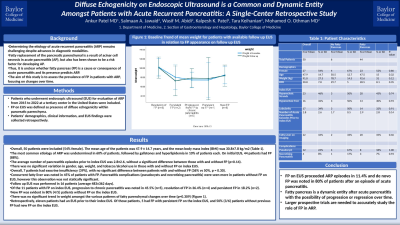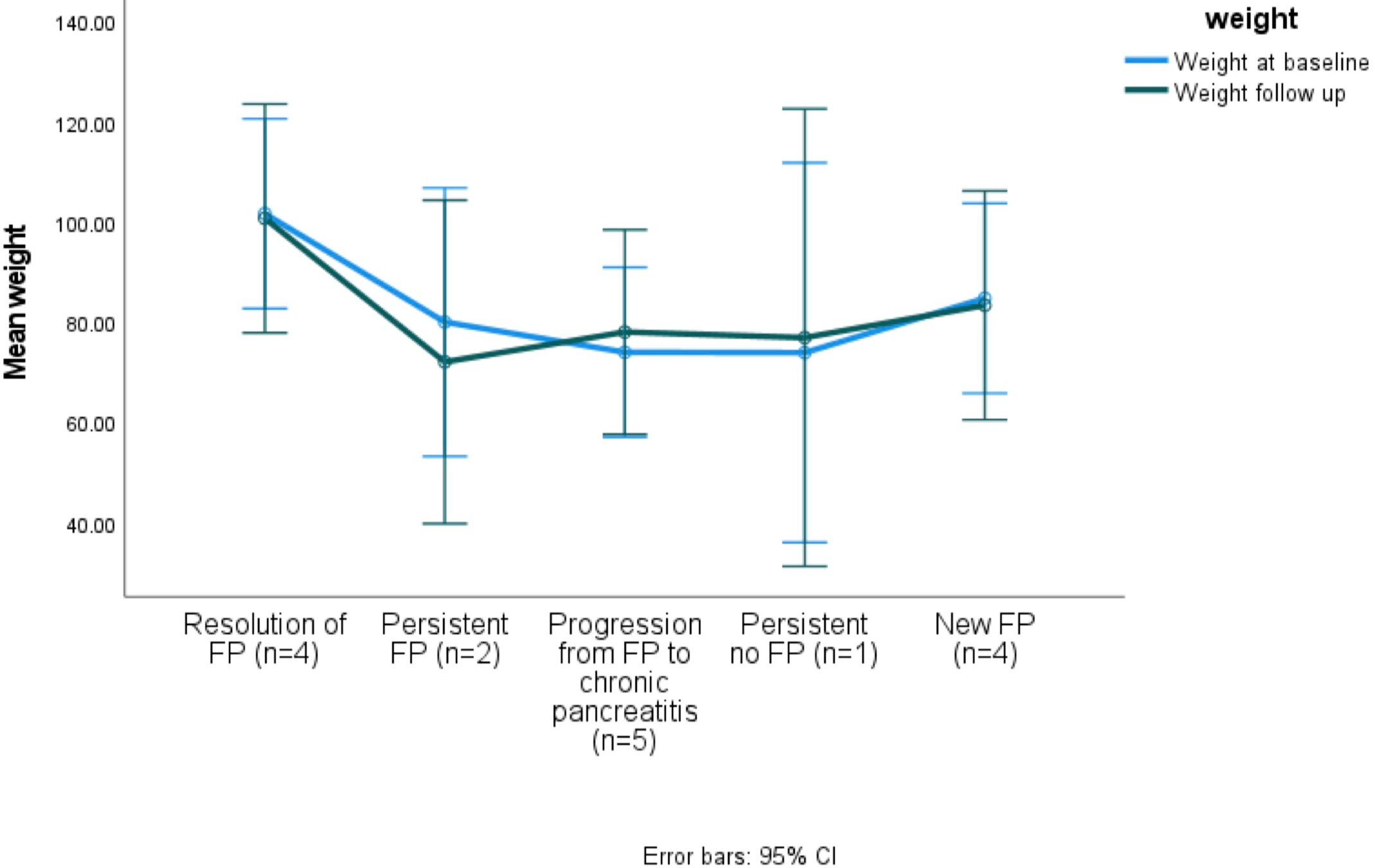Monday Poster Session
Category: Biliary/Pancreas
P1457 - Diffuse Echogenicity on Endoscopic Ultrasound Is a Common and Dynamic Entity Amongst Patients With Acute Recurrent Pancreatitis: A Single-Center Retrospective Study
Monday, October 23, 2023
10:30 AM - 4:15 PM PT
Location: Exhibit Hall

Has Audio
- AP
Ankur Patel, MD
Baylor College of Medicine
Houston, TX
Presenting Author(s)
Ankur Patel, MD, Christo Mathew, MD, Salmaan A. Jawaid, MD, Wasif Abidi, MD, Kalpesh Patel, MD, Tara Keihanian, MD, Mohamed O. Othman, MD
Baylor College of Medicine, Houston, TX
Introduction: Determining the etiology of acute recurrent pancreatitis (ARP) remains challenging despite advances in diagnostic modalities. Fatty replacement of the pancreatic parenchyma is a result of acinar cell necrosis in acute pancreatitis (AP), but also has been shown to be a risk factor for developing AP. Thus, it is unclear whether fatty pancreas (FP) is a cause or consequence of acute pancreatitis and its presence predicts ARP. The aim of this study is to assess the prevalence of FP in patients with ARP, focusing on changes over time.
Methods: Patients who underwent endoscopic ultrasound (EUS) for evaluation of ARP from 2015 to 2022 at a tertiary center in the US were included. FP on EUS was defined as presence of diffuse echogenicity within the pancreatic parenchyma. Patients’ demographics, clinical data, and EUS findings were collected retrospectively.
Results: Overall, 50 patients were included (54% female) with a mean age of 47.9 ± 14.7 years and mean body mass index (BMI) of 30.8±7.8 kg/m2 (Table 1). The most common etiology of ARP was undetermined in 60% of patients, followed by gallstones and hyperlipidemia in 10% of patients each. On initial EUS, 44 patients had FP (88%). The average number of pancreatitis episodes prior to index EUS was 2.8±2.6, without a significant difference between those with and without FP (p=0.14). Overall, 7 patients had exocrine insufficiency (39%), with no significant difference between patients with and without FP (36% vs 50%, p = 0.30). Fatty liver was noted in 45% of patients with FP. Pseudocysts and necrotizing pancreatitis were seen more in patients without FP. Follow up EUS was performed in 16 patients (average 483±362 days). Of the 11 patients with FP on index EUS, progression to chronic pancreatitis was noted in 45.5% (n=5), resolution of FP in 36.4% (n=4) and persistent FP in 18.2% (n=2). New FP was evident in 80% (4/5) patients without FP on the index EUS. There was no significant trend in weight amongst the various patterns of FP changes over time (p=0.309) (Figure 1). Of the eleven patients who had an EUS prior to their index EUS, 5 had FP with persistent FP on the index EUS, and 3 had new FP on the index EUS.
Discussion: FP on EUS preceded ARP episodes in 11.4% and de novo FP was noted in 80% of patients after an episode of acute pancreatitis. Fatty pancreas is a dynamic entity after acute pancreatitis with the possibility of progression or regression over time. Larger prospective trials are needed to accurately study the role of FP in ARP.

Disclosures:
Ankur Patel, MD, Christo Mathew, MD, Salmaan A. Jawaid, MD, Wasif Abidi, MD, Kalpesh Patel, MD, Tara Keihanian, MD, Mohamed O. Othman, MD. P1457 - Diffuse Echogenicity on Endoscopic Ultrasound Is a Common and Dynamic Entity Amongst Patients With Acute Recurrent Pancreatitis: A Single-Center Retrospective Study, ACG 2023 Annual Scientific Meeting Abstracts. Vancouver, BC, Canada: American College of Gastroenterology.
Baylor College of Medicine, Houston, TX
Introduction: Determining the etiology of acute recurrent pancreatitis (ARP) remains challenging despite advances in diagnostic modalities. Fatty replacement of the pancreatic parenchyma is a result of acinar cell necrosis in acute pancreatitis (AP), but also has been shown to be a risk factor for developing AP. Thus, it is unclear whether fatty pancreas (FP) is a cause or consequence of acute pancreatitis and its presence predicts ARP. The aim of this study is to assess the prevalence of FP in patients with ARP, focusing on changes over time.
Methods: Patients who underwent endoscopic ultrasound (EUS) for evaluation of ARP from 2015 to 2022 at a tertiary center in the US were included. FP on EUS was defined as presence of diffuse echogenicity within the pancreatic parenchyma. Patients’ demographics, clinical data, and EUS findings were collected retrospectively.
Results: Overall, 50 patients were included (54% female) with a mean age of 47.9 ± 14.7 years and mean body mass index (BMI) of 30.8±7.8 kg/m2 (Table 1). The most common etiology of ARP was undetermined in 60% of patients, followed by gallstones and hyperlipidemia in 10% of patients each. On initial EUS, 44 patients had FP (88%). The average number of pancreatitis episodes prior to index EUS was 2.8±2.6, without a significant difference between those with and without FP (p=0.14). Overall, 7 patients had exocrine insufficiency (39%), with no significant difference between patients with and without FP (36% vs 50%, p = 0.30). Fatty liver was noted in 45% of patients with FP. Pseudocysts and necrotizing pancreatitis were seen more in patients without FP. Follow up EUS was performed in 16 patients (average 483±362 days). Of the 11 patients with FP on index EUS, progression to chronic pancreatitis was noted in 45.5% (n=5), resolution of FP in 36.4% (n=4) and persistent FP in 18.2% (n=2). New FP was evident in 80% (4/5) patients without FP on the index EUS. There was no significant trend in weight amongst the various patterns of FP changes over time (p=0.309) (Figure 1). Of the eleven patients who had an EUS prior to their index EUS, 5 had FP with persistent FP on the index EUS, and 3 had new FP on the index EUS.
Discussion: FP on EUS preceded ARP episodes in 11.4% and de novo FP was noted in 80% of patients after an episode of acute pancreatitis. Fatty pancreas is a dynamic entity after acute pancreatitis with the possibility of progression or regression over time. Larger prospective trials are needed to accurately study the role of FP in ARP.

Figure: Figure 1. Trend of mean weight for patient with available follow up EUS in relation to FP appearance on follow up EUS.
Disclosures:
Ankur Patel indicated no relevant financial relationships.
Christo Mathew indicated no relevant financial relationships.
Salmaan Jawaid: Boston Scientific – Consultant. ConMed – Consultant. CREO Speedboat – Consultant. DiLumen – Consultant.
Wasif Abidi: Ambu – Consultant. Apollo Endosurgery – Consultant. ConMed – Consultant.
Kalpesh Patel indicated no relevant financial relationships.
Tara Keihanian: ConMed – Consultant. Lumendi – Consultant. Neptune Medical – Consultant.
Mohamed Othman: AbbVie Inc. – Consultant, Grant/Research Support. Apollo – Consultant. Boston Scientific Coporation – Consultant, Grant/Research Support. ConMed – Consultant, Grant/Research Support. Creo Medical – Consultant. Lucid Diagnostics – Grant/Research Support. Lumendi – Consultant. Olympus – Consultant.
Ankur Patel, MD, Christo Mathew, MD, Salmaan A. Jawaid, MD, Wasif Abidi, MD, Kalpesh Patel, MD, Tara Keihanian, MD, Mohamed O. Othman, MD. P1457 - Diffuse Echogenicity on Endoscopic Ultrasound Is a Common and Dynamic Entity Amongst Patients With Acute Recurrent Pancreatitis: A Single-Center Retrospective Study, ACG 2023 Annual Scientific Meeting Abstracts. Vancouver, BC, Canada: American College of Gastroenterology.
